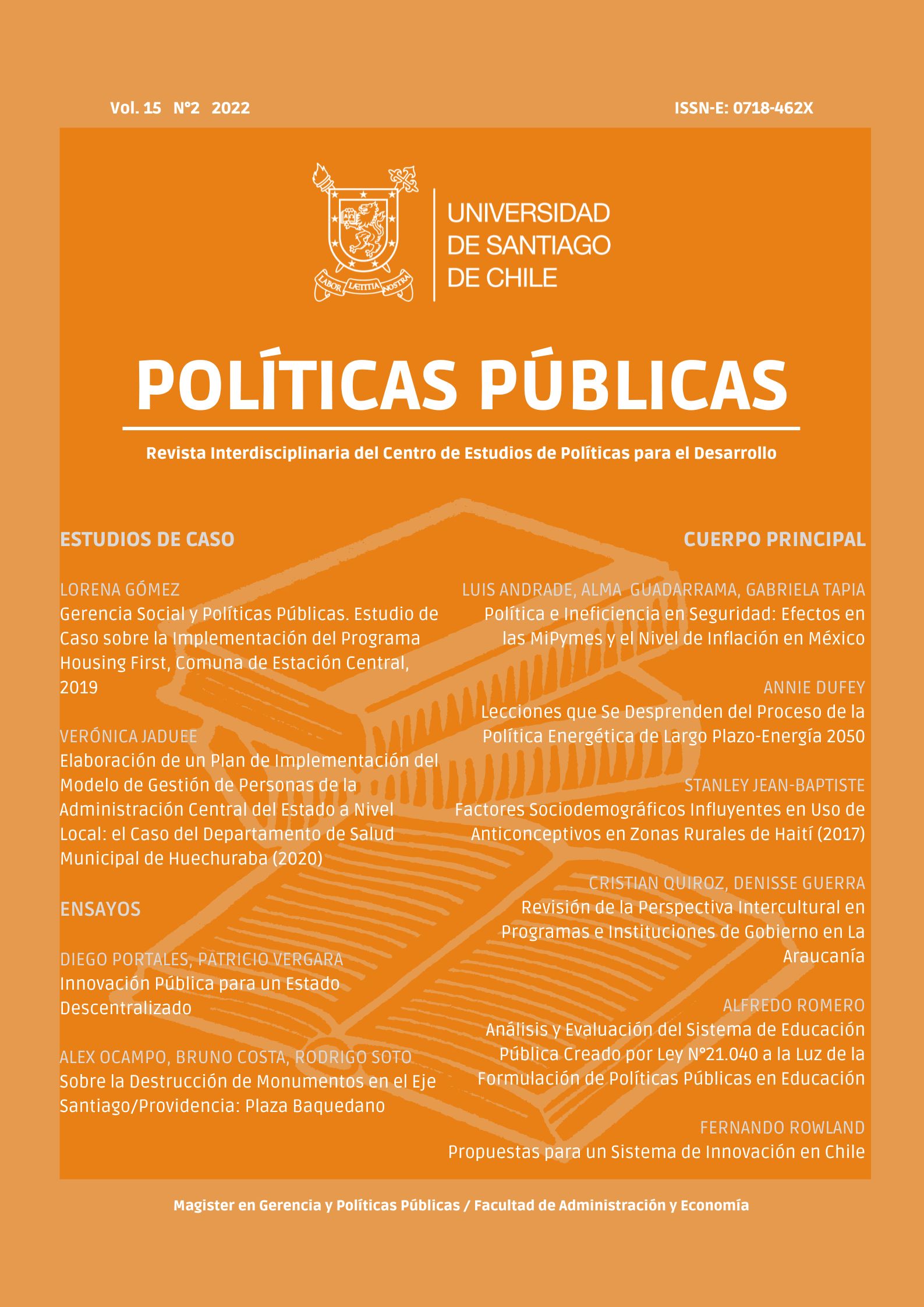Factores Sociodemográficos Influyentes en Uso de Anticonceptivos en Zonas Rurales de Haití (2017)
DOI:
https://doi.org/10.35588/pp.v15i2.5776Palabras clave:
Uso de anticonceptivos, Mujeres en edad reproductiva, Zona rural, Factores sociodemográficosResumen
Este estudio explora los factores sociodemográficos asociados con el uso de anticonceptivos entre mujeres en edad reproductiva casadas o convivientes en sectores rurales de Haití en 2017, utilizando datos de encuestas demográficas y sanitarias. Las variables consideradas fueron edad, religión, educación, preferencia de fertilidad e índice de riqueza. Se realizó un análisis bivariado chi-cuadrado para explorar la relación entre factores sociodemográficos y uso de anticonceptivos, y un modelo de regresión logística binaria para conocer los efectos ajustados de las covariables. Los resultados recomiendan esfuerzos para aumentar el nivel de educación entre la comunidad de menores recursos en las zonas rurales de Haití: educación y servicios de información son especialmente necesarias para adolescentes y adulto-jóvenes.
Descargas
Referencias
Agbadi, P., Eunice, T. T., Akosua, A., & Owusu, S. (20 de April de 2020). Compex samples logistic resgression analysis of predictors of the currentuse of modern contraceptive among married or in-union women in Sierra Leone: Insight from the 2013 demographic and health survey. PLOS ONE, pp. 1-14.
Asiimwe, J. B., Ndugga, P., & Mushomi, J. (February de 2013). Socio-Demographic Factors Associated with Contraceptive Use among Young Women in Comparison with Older Women in Uganda. DHS WORKINGS PAPERS, pp. 1-28.
Dehlendorf, L. (23 de November de 2012). Women's preferences for contraceptive counseling and decision making. An International Reproductive Health Journal Contraception, pp. 250-256.
Gautier, A. (2004). Les politiques de la planification familiale: cinq experiences nationales. Nogent-sur-Marne : Rencontres - CEPED.
Haq, I., Sakib, S., & Talukder, A. (2017). Sociodemographic Factors on Contraceptive Use among Ever-Married Women of Reproductive Age: Evidence from three Deemogrphic and Health Surveys in Bangladesh. medical sciences, 1-11.
Hesketh, T., Lu, L., & Xing, Z. (2005). The effect of China's one-child family policy after 25 years. The New England Journal of Medecine, 1-6.
Hosmer, Jr, D., Lemeshow, S., & Sturdivant, R. (2013). Applied Logistic Regression. New Jersey: John Wiley & Sons, Inc.
IFC (2018). Enquête Mortalité, Morbidité et Utilisation des Services (EMMUS-VI 2016-2017). Petion-Ville, Haiti et Rockville, Maryland, USA: IHE/ ICF.
Irani, L., Ilene , S., & Fotso, J.-C. (2014). Couple Characteristics and Contraceptive Use among Women and their Partners in Urban Kenya. NIH Public Access, 1-26.
Irani, L., Speizer, l., & Fotso, J.-C. (March de 2014). Couple Characteristics and Contraceptive Use among Women and their Partners in Urban Kenya. NIH Public Access, pp. 11-20.
Islam, A., & Mondal, N. (2016). Prevalence and Determinants of Contraceptive use among Employed and Unemployed Women in Bangladesh. International Journal of MCH.
Kohler, H.-P. (2017). Couts et avantages d’etendre les services de santé reproductive sexuelle en Haiti. Fonte: Copenhagen Consensus Center/Creative Commons Attribution CC BY 4.0: https://www.copenhagenconsensus.com/publication/haiti-priorise-family-planning-kohler
Mboane, R., & Battha, M. (2015). Influence of a husband’s healthcare decision making role on a woman’s intention to use contraceptives among Mozambican women. Reproductive Health.
MSPP. (2012). Politique Nationale de Santé. Fonte: Ministère de la Santé Publique et de la Population: Haiti:https://mspp.gouv.ht/site/downloads/PNS%2021juillet%20version%20finale.pdf.
MSPP. (2013). Plan Directeur de Santé. Fonte: Ministère de la Santé Publique et de la Population: https://mspp.gouv.ht/site/downloads/Plan Directeur de Sante 2012 2022 version web.pdf
MSPP. (March de 2019). PLAN STRATÉGIQUE NATIONAL DE SANTÉ SEXUELLE ET REPRODUCTIVE 2019-2023. Port-au-Prince: Ministere de la Santé Publique et de la Population.
Obasohan, P. E. (2015). Religion, Ethnicity and Contraceptive Use among Reproductive age Women in Nigeria. International Journal of MCH and AIDS, pp. 63-73.
Osuafor, G., Mapute, S., & Ayiga, N. (11 de October de 2018). Factors related to married or cohabiting women's decision to use modern contraceptive methods in Mahikeng, South Africa. African Journal of Primary Health Care & Family Medicine, pp. 1-7.
Srikanthan, A., & Reid, MD, FRCSC, R. (9 de November de 2007). Religious and Cultural Influences on Contraception. Division of Reproductive Endocrinology and Infertility, Department of Obstetrics and Gynecology, Queen’s University, Kingston ON, pp. 129-137.
UNDP (2015). World Population Prospects, the 2015 revision: Key findings. United Nations, Department of Economic and Social Affairs, Population Division. Fonte: United Nations: http://esa.un.org/unpd/wpp/.
UNFPA. (2014). ICPD Beyond 2014 Global Report. New York: United Nation.
UNFPA, UNDESA, UN-HABITAT, & IOM. (2013). Population Dynamics in the Post-2015 Development Agenda: Report of the Global Thematic Consultation on Population Dynamics. New York: United Nations.
Ward, V., Santiso-Galvez, R., & Bertrand, J. (2015). Measure Evaluation. Fonte: Family planning in Haiti, the achievements of 50 years: https://www.measureevaluation.org/resources/publications/sr-_15-_118h.
WHO. (2017). World Health Organisation. Fonte: Family Planning Evidence Brief—Accelerating uptake of family planning.



